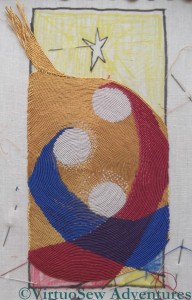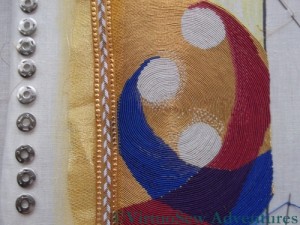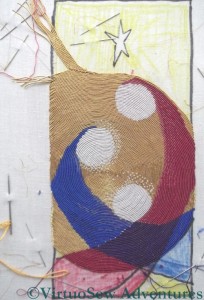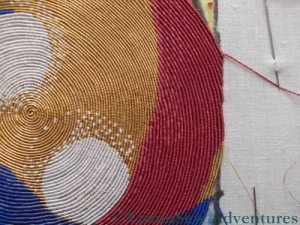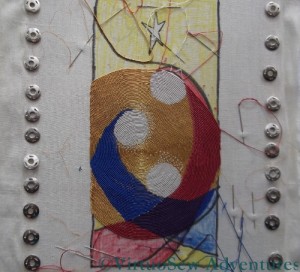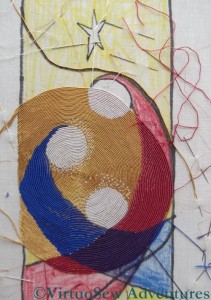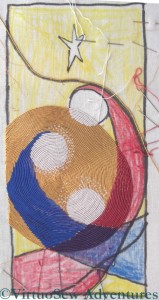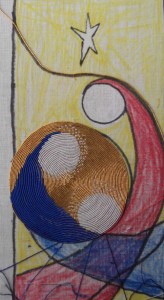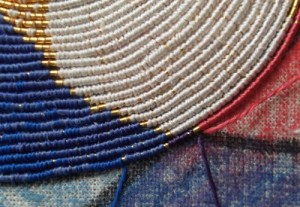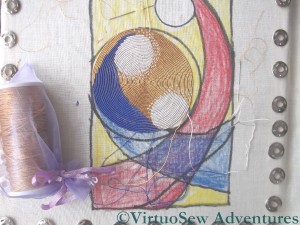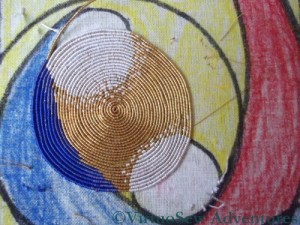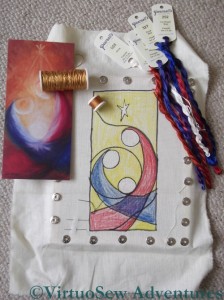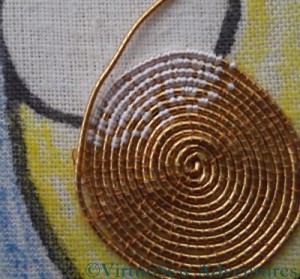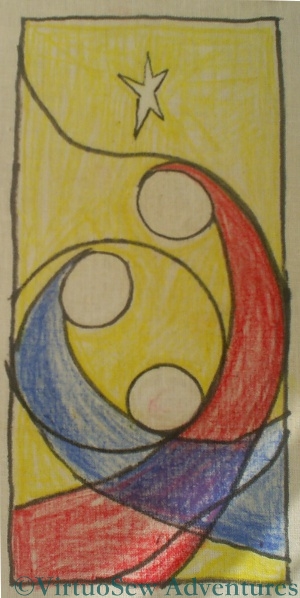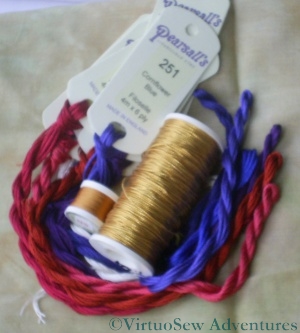Tag: Christus Natus Est
Progress and Thoughts on Mounting
I’ve now got to the stage where I’ve started to leave uncovered gold thread at the bottom, and the sections of silk are reducing in size again. I’ve introduced a third shade of red into St Joseph’s robe, as well. It barely shows in most lights, but I think that it will make a difference in the end, by creating a sort of “ripple” in the appearance of the colour.
While I’ve been stitching I’ve been trying to see whether this interpretation of my mother’s original design says something different to the other versions. What occurs to me now as I look at the photo is that the shape of the Christ Child reminds me of the many Renaissance Nativity paintings in which He is shown with arms outstretched, prefiguring the Crucifixion.
I’ve also been thinking about mounting the piece when it’s finished. I went to the framing shop and looked at their gold card (all much too green), and then thought, since it’s a textile piece, maybe the mount should be textile too. There’s a fabric shop just around the corner, and although they didn’t have anything that was immediately suitable without alteration, they did have a sort of flimsy “cloth-of-gold” which gave me an idea. I’ve overlaid two layers of amber net over the cloth-of-golf in this photo, and the trimmed the edge with a piece of braid I found somewhere else. If I do this it will be nearly as much work as the embroidery was, so I’m hoping that I might have another idea soon!
Both Edges Reached, and beginning to fill in a gap…
I’ve become rather obsessed with making progress on the Christus Natus Est panel. Now that the spiral is finished, and the gold couching only stretches from edge to edge, that progress becomes easier to see.
In particular, not only have I managed to finish the top of St Joseph’s head, and run two or three more rows across the bottom of the panel, but I’ve started to fill in the gap between the spiral and the breakaway line. In fact I’m not sure that I am entirely happy with it – I may have begun to use single threads on both sides of the triangular shape a little early, which leaves some gaps in the coverage.
I will have a lot of tidying up and corrective stitching to do, even when the whole fabric is covered with gold. I need to finish the Christ Child’s halo, and put St Joseph’s in place. I also need to correct the curve of the Virgin’s gown, which is a little flat and straight.
I don’t yet know whether I will stitch rays coming from the star. I think that decision will be made only when the rest of the piece is finished.
I’m beginning to think about the mounting and framing of this piece. I think it will need a wide mount, because such a vibrant piece will need plenty of air between itself and the frame. One possiblity involves a mount covered in cloth of gold or gauze, and trimmed with braid or crystals. If I can’t find a suitable fabric, I will have to hope for a mount card in the right shade of gold. A cream mount would look insipid, and a mount in one of the colours would contend for attention with the panel itself. It’s just as well we have a good framing shop nearby!
Still More Progress
I’ve been making more progress, and in fact passed another milestone this past week.
I’ve reached the right-hand edge and started to stitch just on the top section for a while. Suddenly it feels quicker, because although I’m making progress at the same rate as before (the stitching itself hasn’t speeded up!) I sometimes manage two or more rows in a session, and the sections of design that are covered are side-by-side, and thus more noticeable.
So here is the whole thing to show the progress that I’ve made. I’ve unpicked and removed the line of gold I put in following the black line, because in fact it isn’t running exactly where I want it to, even if it is running along the line I drew.
I sink the threads in batches at the end of a session, which means they don’t slow me down when I’m nicely “in flow”, but it looks neat and easy to understand when I get back to it. When I’ve reached the black line (the correct one!) I shall stop working on the top section and work on the bottom section until that is done, then I will have the last section to work which should go more speedily as there will only be one colour to stitch.
I’m beginning to have hopes of finishing this in time to use it as a Christmas card. Now I just need to work out how to frame it…!
Another Landmark on Christus Natus Est
I’ve got to the point where the lower ends of the robes of Mary and Joseph have both been started, which also brings me very close to the other edge of the panel.
It’s been a little slow of late, partly because the weather has been frightful – grey and overcast. Stitching goldwork in bright sunshine is a recipe for eye fatigue (learn from my mistakes, Gentle Reader!) but at the same time the rich red of Joseph’s robe and the purple of the Christ Child both become quite difficult as the day turns darker. I’m finding that if I want to make progress, everything else has to come second to doing a row or two when the light is good. Sometimes I’m so busy doing other things that I only realise quite late that I’ve missed the best of the light. Very frustrating!
The other reason it has been slow is that I have so many needles in operation – ten of them! Every change of colour means putting one needle aside and picking up another, and while this is a tangible demonstration of progress, and therefore welcome, it does rather slow me down!
I’ve been talking recently with a friend who has been trained in icon painting, and it’s fascinating to hear about the layers of meaning and symbolism in the materials, preparations and even in the process. I’m working so hard on developing a technique here, that I’m not necessarily managing to turn my version into a spiritual exercise as well, although I do sometimes feel that I’m not a million miles away from stitching-as-meditation.
Well, St Benedict said “Laborare est orare” (“To work is to pray”). So maybe I’m onto something, after all.
Progress on Christus Natus Est
Since the Christus Natus Est panel seemed to be so popular, I thought I’d provide another update.
As you can see, the curves that indicate the Virgin’s robes aren’t right at all. I can correct that later, rather as I will correct the Christ Child’s halo – and indeed, put in St Joseph’s halo, which I decided not to attempt to include in the first stitching, because the other two haloes presented such challenges!
You can see that I have loads of needles working with all the different colours of silk and several sections of gold. It’s always more difficult working from the far end of a colour section (relative to the direction of the spiral) and using more than one colour on the robes has helped me there, because I’ve usually managed to have at least one of the colours placed in such a way as to help by catching the gold thread in place. Otherwise, because it is so springy, it’s hard to keep the curve smooth, and in a couple of places the thread is longer than it should have been and creates a slight gap with the line before.
Don’t those rows and rows of gold create a gorgeous background, though!
Two Milestones Passed!
I’ve been making good progress on the Christus Natus Est panel. I’ve had to re-stretch the fabric, which involved taking out all of the pins, and reinstating them. The stitching is much easier again now!
I’ve reached the point at which I decided to end the spiral, which has gone over the outline I originally drew for the panel but now delineates the new left-hand edge. This is rather an important stage, since apart from anything else just following the spiral was an easy thing to do, whereas now – as the gold thread along St. Joseph’s back is hinting – I’m moving on to the part in which I need to create a flowing effect which is linear rather than spiral. The points at which the gold changes direction, and the way in which the lines run will make or mar the design, I think.
I’ve also worked a little more on the Christ Child’s halo. If you zoom in on the picture, I hope you will see that there is now a gap, an incomplete pattern in the halo where I’ve outlined it to come back and fill it in later. I felt it was more useful – and more important – to work out where the edge was to be than to keep the infill going.
The close up shows the blue of the Virgin’s robe, the first hint of red of St. Joseph’s robe, and the combination of white and purple that represent the Christ Child. As someone hinted in the early comments on this project, this is a very addictive technique. I find myself trying to finish “just one more row” before the light fails, and muttering discontentedly when I have to stop.
It may even be finished in time to be used as the family Christmas card!
More on Christus Natus Est
Recently I was sent a link to a page discussing Russian embroidered icons. It seems that for all we think of icons as purely painted pieces, embroidered icons aren’t new – it is simply that their relative fragility and the length of time it takes to create one have made them very much rarer.
As I can testify. There have been many hours already that have gone into this piece, and I’m not sure that the progress made is really all that clear. Still, the spiral is nearly touching the side (I’m going to cover all the black lines, because I’m not entirely sure how this will be mounted or framed), and in fact it won’t be long before I have to consider how the non-spiral lines will flow. If you go back and look at the design as I showed it in this earlier post, you will see there is an extra black line flowing from St. Joseph’s head towards the top left corner, and another in the bottom right. These lines are to change the direction of the lines of the gold in order to bring more life into the design, but now I have done some of the work I wonder whether the lines are in the right place.
There is also the section of the Virgin’s cape running up over her head where I have for now followed the line as drawn, but wonder whether I should perhaps in this one instance follow the line of the gold to maintain the clarity of the abstract shape. If I do that, it will provide some justification for using a line along the back of St Joseph’s head and cloak as one of the new lines for the gold.
In other words, more thinking needed!
Spiralling Onward
Since I’ve received so many comments – and additional e-mails! – asking me to post more about Christus Natus Est, I’ve decided to post about it more frequently than I originally intended.
Progress has slowed somewhat as the spiral gets larger, with ever-longer sections of the close silken stitching. Since I’m using two shades of blue at present, the blue of the Madonna’s robe involves three different threads, which means that every time I feel I’ve settled into a rhythm, I have to stop and change to another thread.
I’ve already had to reposition the fabric on the frame, since the constant close stitching had stretched it slightly. It’s much easier to work this style when the fabric is absolutely taut, so I expect that this will become a regular activity!
You’ve probably noticed that the Christ Child’s halo has a somewhat sawn-off look, and that I’ve not continued the Madonna’s halo over her robe. In both cases, this is because I have taken note of what one of the books I’ve been reading has told me – it is not difficult to add stitches to an or nué piece, but it is near-impossible to take them out. I’m not certain that I want the halos to spread over the robes, so until I’ve decided that, they won’t. I’m happy to go back over the piece tidying up when I’ve finished, so that is how it will be done.
Starting the Christus Natus Est Or Nué Panel
I know I should try to limit the number of projects I work on at once, but my fingers have been itching to start the Christus Natus Est Panel, and I finally decided to have a go.
I bought the silk thread (Pearsall’s Filoselle) and the gold passing thread, at the Knitting and Stitching Show in Harrogate last year. The Filoselle is a beautiful stranded thread, and I’m using a single strand to couch down the colours of the thread, and a different, very fine thread to couch down the bare gold sections.
I was somewhat afraid that choosing to work my or nué panel in the circular and curving fashion would create considerable headaches, especially in starting the spiral at the centre of the circle, but actually it was fairly straightforward. I’ve put the gold thread into a little gauze bag, which keeps it from unwinding- mostly- and means I don’t have to worry about it snagging or catching as I work
As my spiral becomes larger, and the number of colours I am using in each circuit increases, the work will become slower, and more confusing, but so far, I am enjoying it very much. It would be much easier if I had a proper slate frame and trestles to stand it on, as I can see that the pins holding the calico to the frame will need to be moved occasionally as the fabric stretches. However, the silk thread covers the gold reasonably easily, and since I was aware from reading about the technique that the silk would distort the rows slightly, I’ve not been unduly disturbed by the way the spiral isn’t quite circular anymore. It won’t be that obvious when the piece is finished, after all!
In fact I’ve been enjoying myself so much that I just have to be a little careful not to get so wound up in it that I stitch for too long and end up with fuzzy eyes!
Christus Natus Est – Second Stage
The first step is to simplify the design, so that it becomes an embroidery design rather than a painting. I’ve transferred the simplified design using fabric crayons, and used a fabric pen to outline the sections. The design is about three inches by eight, which seems very large now I look at it, but I felt that if I tried to work it too small I risked multiplying the difficulties already inherent in learning a new technique.
The additional lines are contours for the gold threads, which I am going to couch down following the technique described in All that Glitters, by Alison Cole.
Thanks to some help and advice from Golden Hinde I’ve got the right sort of gold thread – an entire spool of it! I just hope one spool is enough…
I’ve decided to use Pearsall’s Filoselle Silk. As I am not sure how much of the gold will be covered by silk, I’ve only purchased one skein of each colour.
Regular readers will have gathered by now that there is a lot of guesswork involved in my embroidery! I suspect that changes between dyelots won’t matter too much when I am after an impression of rich and changeable colour.

